Maryland is power hungry, and you’re paying the price on your utility bill. Lawmakers and consumer advocates have looked to a solution that would lower rates and, as a bonus, reduce carbon emissions: batteries.
The nondescript metal boxes, often tucked behind treelines, store renewable energy, deploying it at high-demand times. A utility-size battery — 1 megawatt or larger — can power about 600 homes.
But the state has had a hard time getting even a tiny fraction of these projects going.
Maryland wants to be able to store at least 3,000 megawatts by 2033, which could save utility customers $100 million each year, the American Clean Power Association found.
There are just four utility-size batteries in the state, storing a meager 11 megawatts, according to the clean energy tracker Cleanview.
State lawmakers tried to kick-start the construction of batteries six years ago and approved a second push this year. A new law aims to lure two 800-megawatt batteries to Maryland by 2027 and requires Baltimore Gas and Electric and other investor-owned utilities to add 150 megawatts of storage by November 2028.
Read More
That would get the state more than halfway to its 2033 goal. But it may be unrealistic.
Battery developers have submitted proposals to build over 3,900 megawatts of storage in recent years. But many projects are stuck in a queue, waiting to navigate the regional power grid operator’s process to connect to the grid.
The wait can be so long that builders and their financiers have seen costs increase and abandoned projects.
The grid operator, PJM Interconnection, is overwhelmed. It’s not considering most new submissions until next spring.
President Donald Trump cast more uncertainty on the battery landscape with the passage of the Republican-backed “One Big Beautiful Bill” this month. Batteries came out relatively unscathed, but solar and wind power, which works hand in hand with batteries, is in jeopardy.
Paul Pinsky, director of the Maryland Energy Administration, believes the challenges coming from all sides could push investors away from batteries and clean energy.
“A dark cloud is hanging over all this,” he said.
A project that ran out of juice
Five years ago, the company behind Maryland’s coal-fired plants — the dirtiest way to produce energy — promoted itself as a vanguard of batteries.
Talen Energy, the Texas-based owner of the Brandon Shores and H.A. Wagner power plants in Anne Arundel County, announced in late 2020 that it would cease burning coal by 2025 and build 20 megawatts of on-site energy storage.
The battery would power about 13,000 homes for about four hours during peak demand periods, according to the Maryland Energy Administration. It was part of Talen’s broader ambition to create 1 gigawatt of energy storage across several states, including New Jersey.
Talen Energy tapped Key Capture Energy, an experienced New York-based battery developer and operator, for the Anne Arundel County project. Ralph Alexander, former chairman and CEO of Talen, told Canary Media, a nonprofit clean energy publication, in 2021 that the battery was “expected online within a year.”
Then the timeline ran smack into bureaucracy that Maryland officials and energy experts worry will keep tripping up battery projects.
Talen and Key Capture submitted the project for PJM review of its feasibility, grid impact, and design and construction. That’s a necessary step for having transmission projects join the region’s power grid.
But PJM’s queue was long. Years long. The grid operator saw the number of interconnection requests “nearly triple between 2018 and 2020,” Paul McGlynn, the company’s vice president of planning, wrote in 2024.
The Talen battery’s anticipated October 2021 service debut was pushed to March 1, 2026, according to a PJM analysis.
Costs associated with the battery shot up, documents show.
In the meantime, Talen Energy filed for Chapter 11 bankruptcy in 2022 and restructured. Attorneys for the project met with Anne Arundel County’s Office of Planning and Zoning in March 2023 to discuss plans for the battery, and Talen emerged from the bankruptcy two months later.
Then, at the end of last year, Talen gave up on the battery project. (The company will keep operating its coal plants, costing Baltimore ratepayers millions every year.)
Taryne Williams, a spokesperson for Talen, and Chris Linsmayer, from Key Capture, said in a joint statement that the companies “have mutually agreed not to pursue the Wagner 20MW battery demonstration project at this time.”
They declined to provide details or reasoning for the decision.
“The funding changes, not only from year to year but month to month,” Pinsky said of battery projects generally. “If investors see a better place to put their money, they’re going to do it.”
Take a number ...
S&P Global found that it takes requests in PJM’s queue around 38 months to get to grid connection, the shortest time of all grid operators but still too long for some.
PJM operates the power grid in all or parts of 13 states and Washington, D.C.
The company put the brakes on reviews for most new requests starting in September 2021 to clear its backlog and reform its process.
“We are more than 60% through those original 200,000MW in projects, with 63,000MW worth of projects in the queue that will be processed in 2025 and 2026,” said Jeff Shields, a PJM spokesperson. The queue should fully reopen next spring, he said.
About 45% of the projects submitted since 2020 were withdrawn before completing the interconnection process, according to an April report from Synapse Energy Economics, on behalf of Evergreen Collaborative.
This was “Largely due to PJM’s study delays, lack of transparency in timing and fees and high network upgrade costs,” according to the report.
PJM has said some projects “are being stymied by issues beyond PJM’s control, like federal, state and local permitting, siting and supply chain challenges.”
Climate advocacy organizations have also blamed PJM’s process for the lack of progress — saying the grid operator doesn’t prioritize clean energy projects, which make up a vast majority of the queue, over fossil fuels.

Of the 51 projects advancing through PJM’s queue, 33 are oil-based generators, including upgrades to a natural gas plant in Prince George’s County and a coal power plant in West Virginia. There’s one Maryland utility battery project: 500 megawatts in Harford County, which could power more than 200,000 homes during peak demand.
“PJM is fuel-neutral. We are concerned with reliability, regardless of technology or fuel,” said Dan Lockwood, a PJM spokesperson. “Nearly all of the projects being studied right now are renewable, so I don’t see how anyone could say we are not prioritizing them — that’s all we’re studying.”
It’s not all on PJM, said Dennis Wamsted, an energy analyst at the Institute for Energy Economics and Financial Analysis. Speculative projects with little chance of getting built were joining the queue “just to have a spot,” he said.
“You can’t fault PJM for that, necessarily, but if things had moved quicker, [it] would have discovered the fact that some of them weren’t real, or a lot of them weren’t real, a lot sooner,” Wamsted added.
It’s in Maryland utility customers’ interest for PJM to shore up its review process.
PJM said it will use artificial intelligence to streamline its planning process for new power resources, increase staffing and develop new tools, while speeding up the process for retiring power plants to be replaced by a new resource.
If those reforms are implemented, electricity bills in the grid operator’s region could decrease by 7% by 2036, Synapse’s report found. If not, ratepayers’ costs could increase “by nearly 60%.”
Charging forward

Maryland’s first utility-size battery became operational just four years ago, accompanying a solar farm in Caroline County on the Eastern Shore. In 2023, BGE built 3 megawatts in Southern Maryland.
BGE plans to build more storage, funding about one-third of project costs with a $50 million grant from the U.S. Department of Energy awarded during the Biden-Harris administration. BGE customers would pay the rest through utility bills.
Instead of one big battery, BGE plans to deploy 11 megawatts across 22 small batteries in the Baltimore region. Open Works, Howard County and Civic Works will deploy another 3 megawatts for BGE as community-owned distributed energy resources such as smaller batteries, solar and EV charging.
That project was supposed to be finished by 2030; the Trump administration’s review of Biden grants could cause delays.
There’s also the new state requirement that BGE, Pepco, Delmarva and Potomac Edison collectively bring 150 megawatts online in the next three years. BGE is responsible for the largest share at 87 megawatts, as ordered by the Maryland Public Service Commission.
The Harford County battery is expected to be operational in 2029.


Comments
Welcome to The Banner's subscriber-only commenting community. Please review our community guidelines.